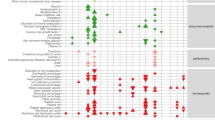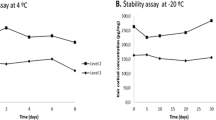Abstract
Background: Hair mineral analyses are being performed frequently both with and without medical advice. Reasons for analysis often are ill defined.
Objective: To assess variability of trace element data both within a series of samples from an individual and among mean values published from other research laboratories.
Design: Many samples of hair were collected carefully from a healthy man over a comparatively long period of time and were processed and analyzed under standard conditions. Extensive published data from other research laboratories also were reviewed and compared.
Results: Coefficients of variation for trace elements in hair of the donor ranged from 17 to 74% for the essential elements copper, selenium and zinc and from 53 to 121% for the potential intoxicants aluminum, cadmium and lead. The ratio of high mean to low mean for values published by others on hair samples from healthy people ranged from two for selenium and zinc to 18 for aluminum.
Conclusions: Hair analysis should be based on a diagnostic hypothesis such as cadmium intoxication or copper deficiency rather than on the ease of analysis or attempts to explain vague symptoms because within-person variability is large and interlaboratory agreement on normal values is poor.
This is a preview of subscription content, access via your institution
Access options
Subscribe to this journal
Receive 12 print issues and online access
$259.00 per year
only $21.58 per issue
Buy this article
- Purchase on Springer Link
- Instant access to full article PDF
Prices may be subject to local taxes which are calculated during checkout

Similar content being viewed by others
References
Aalbers TG (1984): Cardiovascular Diseases and Trace Elements. Dieren: Drukkerij Blok en Zonen.
Anon (1996): Flow Injection Mercury/hydride Analyses. Recommended Analytical Conditions and General Information, pp. 2.14, 2.22. Ueberlingen, FRG: Bodenseewerk Perkin-Elmer Gmbh.
Barrett S (1985): Commercial hair analysis. Science or scam? JAMA 254, 1041–1045.
Bean WB (1980): Nail growth. Thirty-five years of observation. Arch. Intern. Med. 140, 73–76.
Bertazzo A, Costa C, Biasiolo M, Allegri G, Cirrincione G & Presti G (1996): Determination of copper and zinc levels in human hair: influence of sex, age, and hair pigmentation. Biol. Trace Elem. Res. 52, 37–53.
Box GEP & Jenkins GM (1976): Time Series Analysis: Forecasting and Control. San Francisco: Holden-Day.
Bush VJ, Moyer TP, Batts KP & Parisi JE (1995): Essential and toxic element concentrations in fresh and formalin-fixed human autopsy tissues. Clin. Chem. 41, 284–294.
Chappuis P, Duhaux L, Paolaggi F, de Vernejoul MC & Rousselet F (1988): Analytical problems encountered in determining aluminum status from hair in controls and hemodialyzed patients. Clin. Chem. 34, 2253–2255.
Cheng YD, Zhuang GS, Tan MG, Zhi M & Zhou W (1990): Study of correlation of Se content in human hair and internal organs by INAA. Biol. Trace Elem. Res. 26–27, 737–741.
Cornelis R & Speecke A (1971): Neutron activation analysis of human hair collected at regular intervals for 25 years. J. Forensic Sci. Soc. 11, 29–46.
Creason JP, Hinners TA, Bumgarner JE & Pinkerton C (1975): Trace elements in hair, as related to exposure in metropolitan New York. Clin. Chem. 21, 603–612.
Deeming SB & Weber CW (1977): Evaluation of hair analysis for determination of zinc status using rats. Am. J. Clin. Nutr. 30, 2047–2052.
DiPietro ES, Phillips DL, Paschal DC & Neese JW (1989): Determination of trace elements in human hair. Reference intervals for 28 elements in nonoccupationally exposed adults in the US and effects of hair treatments. Biol. Trace Elem. Res. 22, 83–100.
Drasch G & Roider G (2002): Assessment of hair mineral analysis commercially offered in Germany. J. Trace Elem. Med. Biol. 16, 27–31.
Druyan ME, Bass D, Puchyr R, Urek K, Quig D, Harmon E & Marquardt W (1998): Determination of reference ranges for elements in human scalp hair. Biol. Trace Elem. Res. 62, 183–197.
Hunt CD & Shuler TR (1989): Open-vessel, wet-ash, low-temperature digestion of biological materials for inductively coupled argon plasma spectroscopy (ICAP) analysis of boron and other elements. J. Micronutr. Anal. 6, 161–174.
Jacob RA, Klevay LM & Logan Jr GM (1978): Hair as a biopsy material. V. Hair metal as an index of hepatic metal in rats: copper and zinc. Am. J. Clin. Nutr. 31, 477–480.
Klevay LM (1970a): Hair as a biopsy material II. Assessment of copper nutriture. Am. J. Clin. Nutr. 23, 1194–1202.
Klevay LM (1970b): Hair as a biopsy material. I. Assessment of zinc nutriture. Am. J. Clin. Nutr. 23, 284–289.
Klevay LM (1973): Hair as a biopsy material. 3. Assessment of environmental lead exposure. Arch. Environ. Health 26, 169–172.
Klevay LM (1981a): Hair as a biopsy material in the assessment of trace element exposure. Proceedings of the International Conference on Feed Additives. Budapest. ed. S. Szentmihalyi, 3, pp. 11–18.
Klevay LM (1981b): Hair as a biopsy material. VI. Hair copper as an index of copper in heart and kidney of rats. Nutr. Rep. Int. 23, 371–376.
Klevay LM, Bistrian BR, Fleming CR & Neumann CG (1987): Hair analysis in clinical and experimental medicine. Am. J. Clin. Nutr. 46, 233–236.
Klevay LM, Christopherson DM & Shuler TR (2002): Lead in hair and gasoline. Environ. Toxicol. Pharmacol. 11, 141–142.
Leotsinidis M & Kondakis X (1990): Trace metals in scalp hair of Greek agricultural workers. Sci. Total Environ. 95, 149–156.
Liebscher K & Smith H (1968): Essential and nonessential trace elements. A method of determining whether an element is essential or nonessential in human tissue. Arch. Environ. Health 17, 881–890.
Marumo F, Tsukamoto Y, Iwanami S, Kishimoto T & Yamagami S (1979): Effects of hemofiltration and hemodialysis on contents of trace elements in hair, nails and plasma of patients with chronic renal failure. Proc. Clin. Dial. Transplant. Forum 9, 160–164.
Moon J, Smith TJ, Tamaro S, Enarson D, Fadl S, Davison AJ & Weldon L (1986): Trace metals in scalp hair of children and adults in three Alberta Indian villages. Sci. Total Environ. 54, 107–125.
Muramatsu Y & Parr RM (1988): Concentrations of some trace elements in hair, liver and kidney from autopsy subjects—relationship between hair and internal organs. Sci. Total Environ. 76, 29–40.
Mussalo-Rauhamaa H, Kantola M, Seppanen K, Soininen L & Koivusalo M (1996): Trends in the concentrations of mercury, copper, zinc and selenium in inhabitants of north-eastern Finnish Lapland in 1982–1991. A pilot study. Arctic Med. Res. 55, 83–91.
Neve J, Haucoq M & Molle L (1980): Critical study of some wet digestion methods for the decomposition of biological materials for the determination of total Se and Se(VI). Mickrochim Acta 300, 18.
Oleru UG (1975): Epidemiological implications of environmental cadmium. I. The probable utility of human hair for occupational trace metal (cadmium) screening. Am. Ind. Hyg. Assoc. J. 36, 229–233.
Perry Jr HM, Tipton IH, Schroeder HA & Cook MJ (1962): Variability in the metal content of human organs. J. Lab. Clin. Med. 60, 245–253.
Petering HG, Yeager DW & Witherup SO (1971): Trace metal content of hair. I. Zinc and copper content of human hair in relation to age and sex. Arch. Environ. Health 23, 202–207.
Petering HG, Yeager DW & Witherup SO (1973): Trace metal content of hair. II. Cadmium and lead of human hair in relation to age and sex. Arch. Environ. Health 27, 327–330.
SAS (1999): SAS/STAT 8.0. Cary, NC: SAS Institute, Inc.
Schroeder HA & Nason AP (1969): Trace metals in human hair. J. Invest. Dermatol. 53, 71–78.
Seidel S, Kreutzer R, Smith D, McNeel S & Gilliss D (2001): Assessment of commercial laboratories performing hair mineral analysis. JAMA 285, 67–72.
Shrestha KP & Oswaldo A (1987): Trace elements in hair of epileptic and normal subjects. Sci. Total Environ. 67, 215–225.
Sokal RR & Rohlf FJ (1969): Biometry The principles and practice of statistics in biological research, pp. 206–213. San Francisco, CA: W.H. Freeman & Co.
Srivastava AK, Gupta BN, Bihari V, Gaur JS & Mathur N (1997): Hair selenium as a monitoring tool for occupational exposures in relation to clinical profile. J. Toxicol. Environ. Health 51, 437–445.
Sturaro A, Parvoli G, Doretti L, Allegri G & Costa C (1994): The influence of color, age, and sex on the content of zinc, copper, nickel, manganese, and lead in human hair. Biol. Trace Elem. Res. 40, 1–8.
Thimaya S & Ganapathy SN (1982): Selenium in human hair in relation to age, diet, pathological condition and serum levels. Sci. Total Environ. 24, 41–49.
Weiss D, Whitten B & Leddy D (1972): Lead content of human hair (1871–1971). Science 178, 69–70.
Wilhelm M & Idel H (1996): Hair analysis in environmental medicine. Zentralbl. Hyg. Umweltmed. 198, 485–501.
Wilhelm M, Ohnesorge FK & Hotzel D (1990): Cadmium, copper, lead, and zinc concentrations in human scalp and pubic hair. Sci. Total Environ. 92, 199–206.
Yoshinaga J, Imai H, Nakazawa M, Suzuki T & Morita M (1990): Lack of significantly positive correlations between elemental concentrations in hair and in organs. Sci. Total Environ. 99, 125–135.
Zhuang GS, Wang YS, Tan MG, Zhi M, Pan WQ & Cheng YD (1990): Preliminary study of the distribution of the toxic elements As, Cd, and Hg in human hair and tissues by RNAA. Biol. Trace Elem. Res. 26-27, 729–736.
Acknowledgements
We thank Jerry E Pokrzywinski and Thomas R Dryburgh for assistance in collecting the samples, Mary Rydell for typing the manuscript, LuAnn K Johnson for routine statistical analysis, William Martin for bibliographic assistance, Robert Smith for providing the standard hair sample, and Robert Thompson, MD, for obtaining brochures from commercial laboratories that analyze hair.
Author information
Authors and Affiliations
Contributions
The US Department of Agriculture, Agricultural Research Service, Northern Plains Area, is an equal opportunity/affirmative action employer and all agency services are available without discrimination.
Corresponding author
Rights and permissions
About this article
Cite this article
Klevay, L., Christopherson, D. & Shuler, T. Hair as a biopsy material: trace element data on one man over two decades. Eur J Clin Nutr 58, 1359–1364 (2004). https://doi.org/10.1038/sj.ejcn.1601975
Received:
Revised:
Accepted:
Published:
Issue Date:
DOI: https://doi.org/10.1038/sj.ejcn.1601975
Keywords
This article is cited by
-
Relationship between maternal heavy metal exposure and congenital heart defects: a systematic review and meta-analysis
Environmental Science and Pollution Research (2022)
-
Association between congenital heart defects and maternal manganese and iron concentrations: a case–control study in China
Environmental Science and Pollution Research (2022)
-
Occurrence of selected elements (Ti, Sr, Ba, V, Ga, Sn, Tl, and Sb) in deposited dust and human hair samples: implications for human health in Pakistan
Environmental Science and Pollution Research (2018)
-
Trace Element Concentration in Hair Samples as an Indicator of Exposure of Population in the Negev, Israel
Biological Trace Element Research (2013)
-
A Preliminary Study of a Peruvian Diet Using Dietary Analysis and Hair Mineral Content as Indicators
Biological Trace Element Research (2013)



